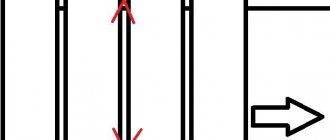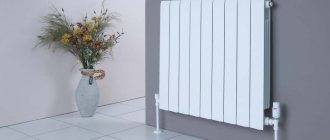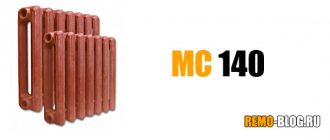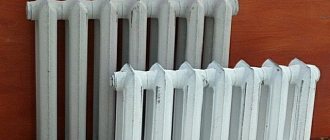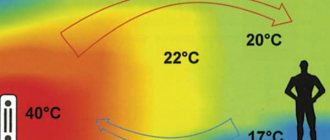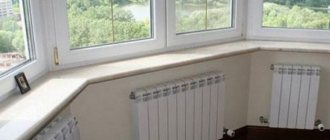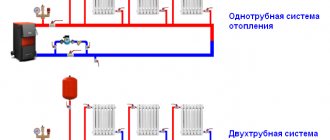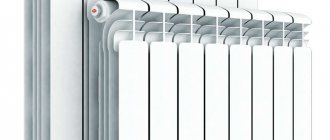Heat dissipation of a cast iron radiator
The power of a cast iron radiator directly depends on the area of its outer surface and lies in the ability to release heat energy at the highest possible coolant temperature. Basically, this value ranges from 80 to 200 watts per section . To calculate the required power, the following formula is used: for 25-30 cubic meters. m. battery power should be 1 kW . If there are several external walls, the power indicator increases.
How much water is in one section of an aluminum radiator, methods for calculating volume
Nowadays, replacing old cast-iron batteries with new models has become not a tribute to fashion, but a vital necessity. Concern for the safety of the heating system and attempts to reduce the cost of utilities have led to more and more consumers choosing aluminum radiators, which differ from other types of heaters in both technical characteristics and price. One of the important parameters is the volume of the heating radiator.
Parameters of aluminum radiators
The technical characteristics of heating batteries are the first thing a consumer pays attention to before purchasing. The most important indicators of a truly high-quality product are:
- The level of heat transfer of one section, since it depends on:
- First, how many elements are needed to heat one room.
- Secondly, how warm the room will be thanks to the radiator.
- Thirdly, what will the microclimate in the room be like?
- Resistance to water hammer and operating pressure of an aluminum radiator.
- Cost of the finished product.
The volume of one section of an aluminum radiator indicates its power and largely depends on how it was manufactured.
If the aluminum battery was made by pressing, then its parts were connected using glue, which makes it vulnerable. Such a radiator is not afraid of corrosion, but increased pressure can damage it.
The capacity of one section of an aluminum radiator, regardless of the method by which it was produced, is almost the same, but the fact that the cast model is stronger and more durable, heats up faster and can be adjusted in size puts them in first place in sales.
Types of coolants
As a rule, the question of what coolant is used in a centralized heating system is not asked, since water always flows through the heating pipe there. Another thing is autonomous heating, where you can choose the best option for a particular house, taking into account the climate of the region where it is built.
Why is radiator volume important?
Calculating how many liters are in one section of an aluminum radiator is important for several reasons:
Considering how many factors are affected by the volume of heating batteries, this parameter should be taken into account when choosing aluminum products.
Calculation of the volume of an aluminum radiator
There are two ways to determine the capacity of a heating battery:
This, although a very labor-intensive method, is the most reliable and accurate, since manufacturers can overestimate or underestimate the parameters of their products in the technical documentation.
When choosing the type of radiator, you should pay attention to the difference in the parameters of domestic and foreign manufacturers. Some indicators may look very attractive, but are not suitable for the centralized Soviet heating system. You also need to think in advance which coolant in the network will be used, and make calculations indicating its viscosity
You also need to think in advance which coolant in the network will be used, and make calculations indicating its viscosity.
To summarize, we can say that the volume of an aluminum radiator is an important parameter that must be taken into account in order for the system to work truly efficiently in the future.
Dimensions of a cast iron radiator.
In the Soviet Union, the overall dimensions of cast iron radiators had a certain standard. In one section, the distance between the centers of the coolant supply and discharge pipes ranged from 30 to 50 cm. The width of the section was not standardized and varied among different manufacturers. Almost all modern batteries also have these standards. The most popular model among cast iron products is MS-140. (installed in many “Khrushchev” and 9-story buildings of the 60-80s). The distance between the centers of the pipes is 50 cm; battery height 58.8 cm; width 9.3 cm; depth - 14 cm. The variety of overall dimensions of batteries is explained by the needs of customers.
How much does one section weigh?
Let's conduct a comparative analysis of heating devices according to this indicator, and take the old Soviet “accordions” as a starting point. So, the weight of one section of the cast iron traditional battery MS-140 is 7.12 kg, and the capacity is 1.5 liters of water with a standard center height of 500 mm. That is, the total mass of 1 radiator section in working condition is 7.12 + 1.5 = 8.62 kg.
Example of mass calculation. As a rule, heating devices with a number of sections from 4 to 12 are used in private houses. Let's take the average number - 7 sections, then the mass of the old-style battery will be 8.62 x 7 = 60.34 kg, and without water - 49.84 kg. It’s not easy to install this kind of colossus alone; you definitely need an assistant.
Below in the table we will present various options for new heaters, including cast iron euro batteries, where we will indicate the indicators that concern homeowners - the weight of the fin, its capacity, heat output and price in conventional units.
| Radiator brand and model | A country | Weight, kg | Coolant volume, l | Thermal power, W | Price, y. e. |
| Viadrus KALOR 500/70 | Czech | 4 | 0.8 | 70.3 | 20.05 |
| Viadrus Bohemia 450/220 | Czech | 9.9 | 2.4 | 110 | 78.25 |
| Demir Dokum Nostalgia 500/200 | Türkiye | 9.6 | 2.3 | 163 | 52.20 |
| Retro Style Anerli 560/230 | Russia | 17 | 3.29 | 189 | 229.60 |
| EXEMET Modern 600/100 | Türkiye | 4.3 | 0.7 | 102 | 32 |
| EXEMET Classica 500/176 | Türkiye | 9.3 | 1.95 | 145 | 76.85 |
Note. The numbers after the brand and model name mean the following: distance between the axes of the plugs / depth in mm.
As you can see, we selected products of approximately the same height and different depths, which affects the massiveness of each rib. To estimate the actual mass of radiators, we suggest calculating it based on the required thermal power to heat a standard room of 20 m². Putting 100 W of heat per square area, we obtain the required heating power of 2 kW.
Manufacturers of cast iron radiators
Most of the Russian market is represented by domestic models. This can be explained by the fact that the cost of transporting cast iron batteries makes up a large part of its final cost. The main manufacturers include:
- CHAZ – Cheboksary Aggregate Plant (Russia)
- Minsk Heating Equipment Plant (Belarus)
- Kiran (Ukraine)
- Viadrus (Czech Republic)
Installation of cast iron radiators.
Almost all cast iron products are composite, consisting of separate sections connected by nipple bushings.
Gray cast iron is used in their manufacture. Paronite gaskets are installed between the individual sections. Horizontally, the flow of water always goes in one direction. Vertically, the current flows through channels, of which there are one or more. Depending on the number of vertical channels, the area and power of the battery increases. Due to the need to maintain strength and surface area, manufacturers cannot change the weight-to-power ratio much.
The large weight of the battery means reinforced fastenings.
How are radiators made?
Since the advent of the first cast iron heating device, little has changed in production technology. All modern radiators are made by casting from cast iron alloy. Since the shape of the battery changed over time, adjustments were also made to the production process: the radiator began to be manufactured section by section. After casting, finished products are assembled at the factory. Each section is fastened to the next one using threaded nipples. Therefore, if a leak occurs in the radiator, it most often occurs either at the point where the device is attached to the heating system, or at the threaded joint of individual sections.
This is interesting!
On these pages you can find out: How much does a piano weigh? How much does a bathtub weigh? How much does a brick weigh? How much does Oka weigh? How much does a ball weigh?
The number of sections of radiators may vary, depending on the manufacturer. Cast iron products produced in the Czech Republic are produced in ten sections, radiators from the Lugansk Foundry and Mechanical Plant of the MS140 brand are produced in four and seven sections. Cast iron batteries were very popular in the USSR. Thin steel radiators, although much lighter, often failed to heat the room, leaked and flooded neighbors. If a cast iron radiator was installed in the room, then such a room was the warmest place in the house. Therefore, having started repairs, Soviet citizens tried to change heating appliances to cast iron ones, obtaining a product that was in short supply. In many apartments, despite the large selection of modern heating appliances, cast iron radiators, the owners still have a very “warm” relationship with them.
Unlike their metal “brothers,” cast iron radiators had another obvious advantage: they were easy to paint. Every owner of a living space in an apartment building, at least once, has encountered the problem of painting radiators. Plate and tubular radiators required annual renewal, and painting them was very inconvenient and time-consuming. With cast iron radiators, the painting process was much faster, since they did not have “tricky” shapes and small parts. From the factory, the heating devices were supplied primed, so you could choose any paint color and paint the surface of the radiator to your own taste.
It was not easy for one person to install a cast iron battery. It wasn't a matter of connection complexity; in order to lift and hold the cast iron radiator, at least the effort of two people was required.
Advantages of cast iron heating radiators
Heating appliances made of cast iron are very resistant to aggressive coolant environments. This is explained by the physical parameters of this metal. Cast iron radiators can remain corrosion-free for a very long time, even at elevated temperatures. In addition, virtually no harm is caused to cast iron and various chemicals added to the coolant.
If the device becomes clogged or leaks, they can be easily repaired. Blockages that occur in the radiator can be caused by the properties of the coolant with a high content of Ca and Mg salts. As a result of deposits on the inner wall of the device, it narrows, which leads to a deterioration in the heating rate and normal heat transfer. A leak in a cast iron battery can occur as a result of wear of the gaskets between the sections. It is better to eliminate all the problems described above during the summer preventive shutdown of water supply.
The cost of a cast iron battery is approximately equal to the cost of analogues made of aluminum and steel. But at the same time, it is worth noting that cast iron withstands water shocks much better and can withstand pressure surges of about 16 bar.
Cast iron devices can be used at high temperatures and pressures, due to their low coefficient of thermal expansion.
The heat output of the heater is quite high. To achieve the greatest effect from this property, special reflectors should be placed behind the cast iron radiator.
Installation of a cast iron radiator is easy, due to the fact that the radiator sections are connected using a threaded connection and paronite gaskets. The battery is connected to the ends of the pipes in the same way. A special key is used for threading, which can be used to disconnect any section without removing the side ones.
Very long product life of more than 50 years. The only thing is that during this time it is necessary to regularly remove deposits and replace gaskets.
Advantages of cast iron
If you do not take into account how much a cast iron battery weighs, you can note a whole range of advantages of heating devices of this type
, which include:
- corrosion resistance;
- resistance to chemically aggressive environments - the material is undemanding to the characteristics of the coolant;
- durability;
- high rates of thermal radiation - the greater the number of sections, the higher the heat transfer of the heating device.
The appearance of standard cast iron batteries is simple and laconic, but today manufacturers also offer antique-style radiators. The advantages of such models include a stylish and respectable appearance.
Various radiator options
Specifications
The power of a heating device is an indicator of its thermal efficiency. When calculating the heating system, the heating needs of the house are taken into account. It is important to know the power of 1 section of a cast iron radiator in order to determine the size of the batteries for each heated room. Incorrect calculations lead to the fact that the room will not warm up properly, or vice versa - you will have to ventilate it often, removing excess heat.
For an ordinary standard radiator made of cast iron, the power of 1 section is 170 W. Cast iron batteries can withstand heating above 100°C and operate successfully at an operating pressure of 9 atm. This allows the use of products of this type as part of central and autonomous heating networks.
Modern models
Manufacturers offer lightweight battery options made of gray cast iron. If the weight of 1 section of the Soviet MC140 radiator is 7.12 kg, then 1 section of the Czech-made Viadrus STYL 500 model weighs 3.8 kg, and its internal volume is 0.8 liters. This means that a Czech radiator of 10 sections filled with coolant will have a mass of (3.8 + 0.8) × 10 = 46 kg. This is 40% less than the mass of a filled MC 140 battery, consisting of a similar number of cells.
Lightweight cast iron heating appliances are also produced in Russia. MODERN batteries are produced under the EXEMET brand, 1 section of which weighs 3.3, and its internal volume is 0.6 liters. These tubular cast iron radiators are characterized by relatively low heat transfer, which requires an increase in the number of links. Heating devices are designed for floor installation.
Vintage cast iron radiators are becoming increasingly popular. These are floor models made using artistic casting technology. Due to the volumetric complex patterns, the weight of the cast iron radiator section is significantly increased, reaching 12 kilograms or more.
Vintage cast iron floor radiator
Life time
Houses built before the revolution still have cast iron radiators installed more than 100 years ago. Modern heating devices made from this material are also designed for decades of maintenance-free operation.
Durability is explained by the strength of cast iron, resistance to heat and pressure. Heating devices made of cast iron do not rust during the period when the coolant is drained from the network and the inner surface of the batteries is in contact with air.
Dimensions
The weight of a cast iron radiator section depends on its height, configuration and wall thickness.
Manufacturers offer models with different characteristics
:
- battery depth ranges from 70 to 140 mm in the standard version;
- link width varies from 35 to 93 mm;
- section volume – from 0.45 to 1.5 l depending on the dimensions;
- height of the heating device in the standard version is 370-588 mm;
- center distance – 350 or 500 mm.


